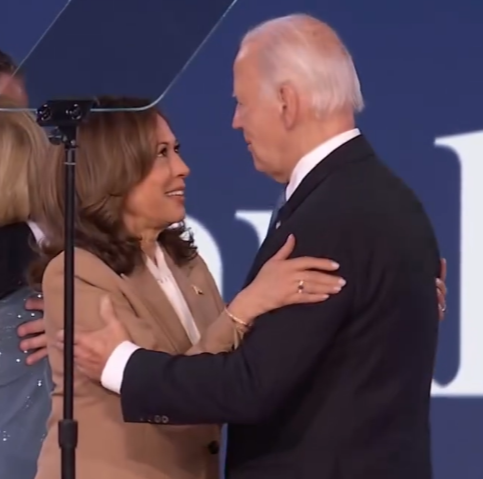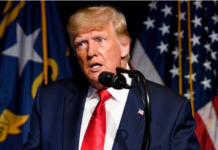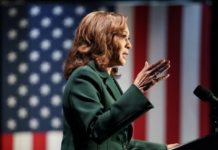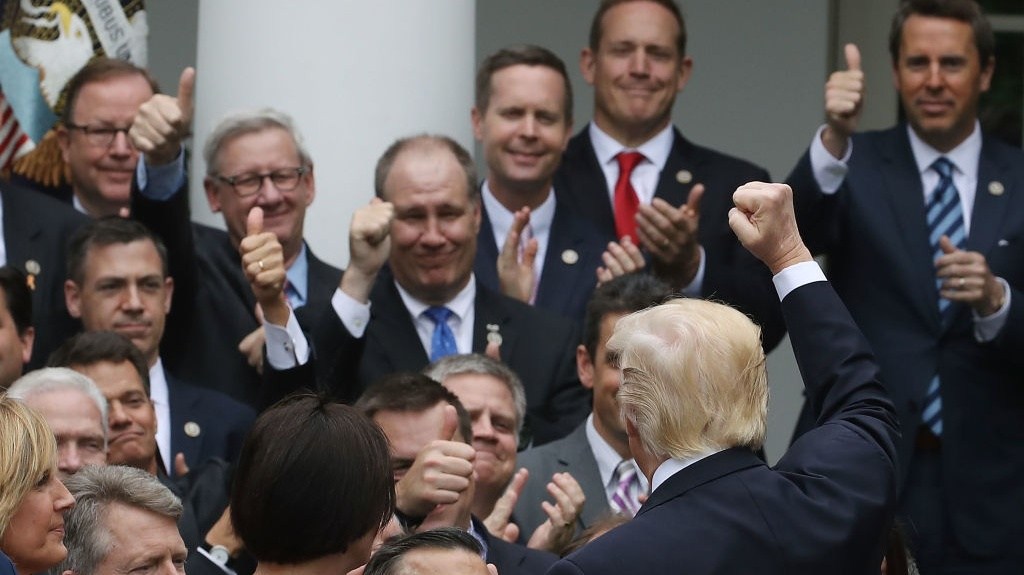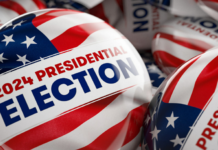By Errin Haines/Originally published by The 19th
This column first appeared in The Amendment, a biweekly newsletter by Errin Haines, The 19th’s editor-at-large. Subscribe today to get early access to future Election 2024 analysis.
When Vice President Kamala Harris officially becomes the first woman of color to accept a major American political party’s nomination for president at this week’s Democratic National Convention in Chicago, it will be a moment made possible in part by President Joe Biden.
Harris’ Thursday night acceptance speech has been four years in the making, starting with Biden’s 2020 primary debate-stage declaration that he would choose a woman running mate. His choice of Harris then, his pledge that she would be a “full partner” in his presidency, and the endorsement of his vice president as Biden made the difficult decision to end his 2024 campaign demonstrated an early confidence in her leadership and a continued commitment to empowering her in office that has translated into his enthusiastic support for her candidacy.
On Monday night, he emphasized the ties between the two, frequently saying “Kamala and I” when discussing his administration’s accomplishments. Biden urged people to vote for Harris and reject Donald Trump. He called choosing her as vice president “the best decision I ever made in my whole career.”
“She’s tough, she’s experienced, and she has enormous integrity. Her story represents the best American story. And like many of our best presidents, she was also vice president,” Biden said, with a smile.
“No matter what you want to say about him, Biden’s legacy is linked to the first Black president and the first Black woman on a major party ticket,” said presidential historian Alexis Coe. “That is a remarkable legacy for any president, let alone a White man of his age. By choosing Kamala Harris, he’s also made the issue of age and his insistence that he was still running a chapter, at most, in his biography. … Everything else will fall into this long shadow of this.”
When Biden announced his intent to choose a woman vice president before he became his party’s nominee for president, it was a recognition of women as the majority of the country’s population and electorate. On August 11, 2020, he chose Harris from among a field of qualified women whose careers and credentials were all spotlighted during a process that was public and, at times, highlighted how women’s ambition is often viewed suspiciously and their “likeability” questioned in a way men’s isn’t.
The role of the vice president has taken on increasing relevance in recent years, including Dick Cheney under President George H.W. Bush and Biden under President Barack Obama. The vice presidency is also among the most successful stepping stones for presidential nominees and eventual presidents. When she ran unsuccessfully for president in 1972, Democratic New York Congresswoman Shirley Chisholm predicted that the path to the presidency for a woman would run through the office.
In choosing Harris, Biden was also sending “an important message to the country about where we were heading,” said Anita Dunn, a longtime Biden adviser.
“His choice of Kamala Harris was because he felt she was the best qualified person to be vice president, but having a woman in the pipeline is the critical piece to having more women, more diversity of representation in critical decision-making roles,” said Dunn, who’s now a senior adviser to a PAC supporting Harris.
It was also the fulfillment of numerous campaign promises in one person, said Cedric Richmond, a former Biden senior adviser and now a DNC senior adviser.
“He had been resolute in that he wanted to bring this country together, tackle systemic racism and create a very diverse administration,” Richmond said. “He set the tone for that by picking then-Senator Harris.”
Once in office, Harris’ vice presidency got off to an uneven start. She was criticized for not being visible enough and for having a muddled message, particularly on immigration. The closeness and authenticity of the partnership between Biden and Harris was questioned.
But in the White House, Biden was insistent not just that Harris had a seat at the table, but that she would be the last one in the room. She was there helping him make critical decisions during his presidency on issues foreign and domestic, from the coronavirus pandemic, to the administration’s response to the Supreme Court’s decision to end federal protections for abortion, to confronting Russia’s war against Ukraine and the Israeli-Palestinian conflict in Gaza.
Biden also assigned Harris a portfolio that included some of the most intractable political and social challenges, from voting rights, to the root causes of migration, to criminal justice reform, to gun violence. And she has taken the lead on access to reproductive care — including abortion and maternal mortality — in the two years since the Supreme Court’s ruling to overturn the 1973 Roe v. Wade decision. In many ways, that decision and Harris’ public profile in its wake were a turning point, putting her front and center on one of the biggest issues of their time in the White House.
“If we look at what she has been tasked with, we see that in many ways, she’s been preparing for this moment because of Joe Biden,” Coe said.
Their partnership evolved into a genuine friendship, one that was on display Monday. Harris’ surprise appearance on opening night included watching Biden’s remarks in the arena, and their mutual affection was visible during and after his speech.
Dunn added that in normalizing and elevating her leadership, Biden helped to introduce Americans to the Harris he chose and reinforced her readiness to serve.
“Because she’s been vice president and because people have been seeing her lead as someone who is representing the United States abroad as well as at home, no one is questioning now whether she’s qualified to hold the office,” Dunn said. “That’s a huge piece.”
But Biden’s relationship with Harris is only the highest-profile example of his record on gender as president and in half a century of public service.
On his first day in office, Biden established the White House Gender Policy Council to advance gender equity across the administration and address a range of issues, including economic security, health, education and gender-based violence, that are contributing to barriers to equity.
Biden’s judicial appointments are also the most diverse of any U.S. president to date by race, gender and professional background, including 75 percent women, 47 percent women of color and the most federal judges to appellate courts who have previously worked as public defenders. In 2022, he fulfilled another 2020 debate-stage promise, nominating Ketanji Brown Jackson, who became the first Black woman Supreme Court justice.
Biden has pointed to the Violence Against Women Act, which he introduced as a United States senator in 1990, as among his proudest political accomplishments.
But the following year, as chairman of the Senate Judiciary Committee, Biden presided over a dark moment in politics: the 1991 nationally televised testimony of Anita Hill during Clarence Thomas’ confirmation for the Supreme Court. Hill, a Black woman who worked for Thomas at the Department of Education and the Equal Employment Opportunity Commission, told the all-man committee in humiliating and vivid detail that Thomas had sexually harassed her when he was her supervisor. Biden was criticized for his hands-off approach to proceedings that felt at times hostile toward Hill and were received more broadly by American women as sexist.
When a record number of Democratic women ran for Congress the following year, Biden campaigned for some of them. And he recruited two of the women who became senators — Dianne Feinstein of California and Carol Moseley Braun of Illinois — to serve with him on the Judiciary Committee.
“When you look at Joe Biden’s record on gender, it’s not perfect, but what’s remarkable is that he takes these stances, he’s called out for it, he thinks about it, and he comes into the light,” said Coe. “It doesn’t undo what has been done, but this is a man who, even at this point in his life, is always trying to be better.”
A month ago, convention planners were prepping for Biden, 81, to make the Thursday keynote. That changed on July 21, when Biden ended his reelection campaign and endorsed Harris, 59. He spoke on the first night of the convention, laying out his plans for the end of his presidency and making the case for why the woman who has been his partner for four years should now be his successor.
His words were met with extended applause and chants of “Thank you,” Joe” and “We love Joe,” appreciation for his service, his sacrifice and what he made possible.
“I made a lot of mistakes in my career, but I gave my best to you,” Biden told the crowd.
It is a testament to “the critical importance of having people who are willing to not just offer lip service to the importance of promoting and actively pushing and looking a little harder” for women leaders, but who are doing it, Dunn said.
“The progress we make in this country is not a straight line, but this feels like a very big piece of progress, because she is the candidate now, people already see her as someone who can be president, and that is no small thing,” Dunn said.
In putting the country first, Biden has also helped to create another first in American politics — which could perhaps be among the largest pieces of his legacy.
“He had a decision to make, and then he looked to see who he thought could unite the country, who could lead it forward with the same value system of respecting people and uplifting working families,” said Richmond. “Those are things they share, and he didn’t have to look far. He knew who he picked when he picked her, and it was a logical fit.”





















